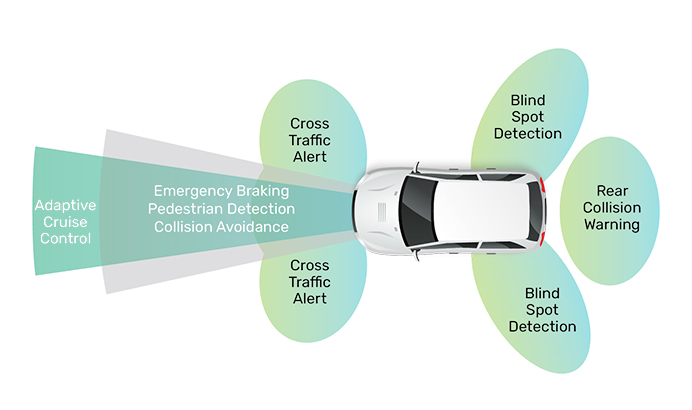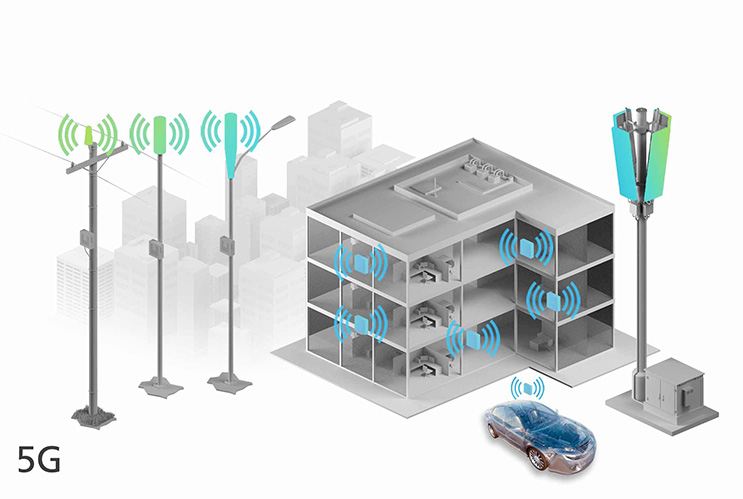Datasheet
ConnX Family of Radar, Lidar, and Communications DSPs
Configurable, extensible, scalable
The Cadence Tensilica ConnX family of enhanced digital signal processors (DSPs) establishes a new standard in high-performance, low-power digital signal processing specifically designed for radar, lidar, and communications processing. Optimized for complex number processing, the ConnX DSPs offer a wide range of software-compatible power, performance, and area (PPA) points to suit the needs of any application. These DSPs provide the scalability needed to deliver energy-efficient programmable solutions for radar, lidar, and communications applications (such as infrastructure, user equipment, IoT, and V2X). Easily optimized through check-box options, the ConnX DSPs provide unprecedented flexibility in implementing systems at power consumption levels that significantly reduce the need for hardware accelerators. The four members of the family include the ConnX 110, ConnX 120, ConnX B10, and ConnX B20 DSPs.
Overview
Features
| Tensilica ConnX DSPs | ||||
|---|---|---|---|---|
| Throughput | 110 | 120 | B10 | B20 |
| Vector/Memory width (b) | 128 | 256 | 256 | 512 |
| MACs 8bx8b | 32 | 64 | 64 | 128 |
| MACs 16bx16b | 32 | 64 | 64 | 128 |
| MACs 32bx32b | 8 | 16 | 16 | 32 |
| SP FP FMA | 8 | 16 | 16 | 32 |
| HP FP FMA | 16 | 32 | 32 | 64 |
| DP FP FMA | 4 | 8 | 8 | 16 |
| ALU 8b | 48 | 96 | 96 | 192 |
| ALU 16b | 24 | 48 | 48 | 96 |
| ALU 32b | 16 | 32 | 32 | 64 |
| Divider 16b | 1 | 2 | 2 | 4 |
| Divider 32b | 0.5 | 1 | 1 | 2 |
Notes:
MAC: Multiply-accumulate operation
FMA: Fused multiply-add operation
ALU: Arithmetic logic unit
SP FP: Single-precision floating point
HP FP: Half-precision floating point
DP FP: Double-precision floating point
Benefits
High Performance, Energy Efficient, Maximum Flexibility
Fast time to market, evolving standards, and long platform lives are all incompatible with the rigidity of ASIC-based designs for next-generation products. Whether it’s a product targeting a 5G communications microcell, access point, mobile hotspot, tablet, smartphone, car-2-car, car-2-infrastructure, or a higher resolution imaging radar sensor or a lower-cost solid-state lidar, they all benefit from the flexibility of a software-based solution as these markets develop and mature. This flexibility can only be achieved by implementing parts of the signal processing chain on programmable processors.
The ConnX DSPs are built on Cadence’s proven Tensilica Xtensa customizable processor architecture and are specifically designed to support the needs of radar, lidar, and communications signal processing. They deliver the processing capacity needed in single- and multi-core systems with an instruction set specifically targeted at the processing requirements in these markets. As needed, hardware blocks may be interfaced to the Tensilica ConnX processors via dedicated custom interfaces under the ConnX processor control or as initiator/responders via the system bus interfaces or via shared memory.
Beyond simple software programmability, support for push-button assembly of optimized processors is at the heart of all Xtensa-based ConnX products. This includes the ability to:
Whether implemented as a single core, as an array of ConnX DSPs or a hybrid system on chip (SoC) made up of a diverse mix of ConnX processors and hardware accelerator blocks, the ConnX DSPs are there to do the heavy lifting at the intersection of maximum performance, low energy, and design flexibility.
Configurable, Extensible, Scalable
The Tensilica ConnX DSPs provide pre-verified accelerator instruction options. These options are included/excluded as checkboxes when defining a core and result in the seamless integration of that feature into the hardware, the compiler, the modeling tools, and the verification scripts. With these capabilities, you can build a custom DSP without the large development schedule impact that a change in hardware design would normally involve.
The ConnX DSPs can be extended to support custom ports and queues for efficient, direct, connection to offload accelerators and are fully supported in the programming and modeling tools. These custom interfaces can be defined to match the interfaces of existing third-party IP. Thus, the ConnX DSPs can access hardware offload accelerators in a deterministic single- or multi-cycle operation, greatly reducing power consumption and without impacting the shared system bus.
Application Space: Radar, Lidar, 5G Communications
The Tensilica ConnX family products are high-performance DSPs designed for next-generation radar, lidar, and communication systems (including legacy support for 4G, LTE Advanced, LTE, WCDMA, HSPA+, Wi-Fi, and DVB). Higher precision options are specifically designed to meet the accuracy and performance requirements associated with the advanced MIMO systems needed. In addition to vector-based filtering, FFT, and linear algebra-processing capabilities, a fully featured instruction set includes a full range of bit-oriented operations. The ConnX processors excel at running control code and are used to perform the PHY application layer control in addition to digital signal processing, providing opportunities for hardware savings and a broader scope of applications than a dedicated fixed hardware solution could provide.
As physical layer (PHY) system developers move to advanced standards such as 5G, and radar system developers add more antennas for higher resolution, they face the need for dramatic increases in performance from their processing platforms. The ConnX DSPs meet this challenge with their highly parallel vector engines and, with compatible architectures, provide an easy upgrade path to other ConnX family members when needed. If processing needs scale beyond that of a single DSP, the ConnX family provides smooth support for multi-core solutions.
As systems become more diverse with wide-scale deployment of heterogeneous networks, the solution that may work best for a microcell operating on a bullet train in Japan may be very different from a similar microcell operating in a subterranean pedestrian mall in downtown Montreal. A programmable software-based solution using a ConnX DSP allows you to implement both solutions on a single platform and allows it to evolve without going back for an expensive and time-consuming respin of the silicon.
With a solution based on a ConnX DSP, you can deliver a working solution in less time than a traditional hardware or a hybrid hardware/DSP design. You can also deploy this programmable hardware platform for a broader range of applications and over a longer period of time. Ultimately, this reduces costs and results in a faster time to market, helping you deliver more competitive solutions in the marketplace.
Toolchain
The Tensilica ConnX DSPs are delivered with a complete set of software tools. The toolset includes a high-performance C/C++ compiler with automatic vectorization and instruction bundling to support the VLIW pipeline in the DSP. This comprehensive toolset also includes the linker, assembler, debugger, profiler, and graphical visualization.
A comprehensive instruction set simulator (ISS) allows you to quickly simulate and evaluate performance. When working with large systems or lengthy test vectors, the fast, functional TurboXim simulator option achieves speeds that are 40X to 80X faster than the ISS for efficient software development and functional verification.
Xtensa SystemC (XTSC) and C-based Xtensa Modeling Protocol (XTMP) system modeling are available for full-chip simulations. Pin-level XTSC offers co-simulation of SystemC and RTL-level offload accelerator blocks for fast, cycle-accurate simulations.
The ConnX DSPs support all major back-end EDA flows, and represent the ultimate in customizable DSPs from Cadence, the leader in configurable, extensible, and scalable solutions for advanced radar, lidar, and communications systems. This proven development environment for both hardware and software reduces time to market and risk, as well as providing maximum flexibility in processing solutions for radar, lidar, communications, and beyond.


